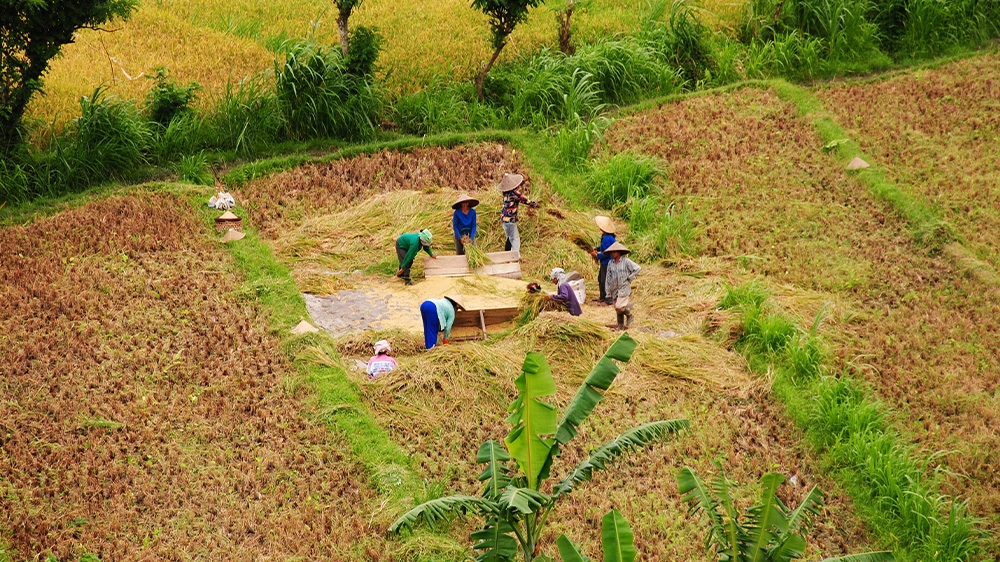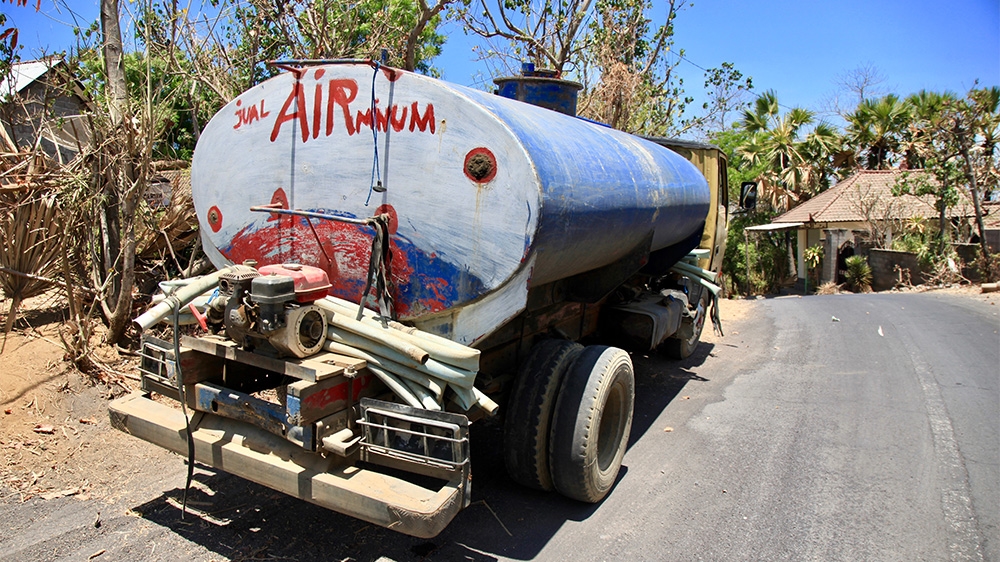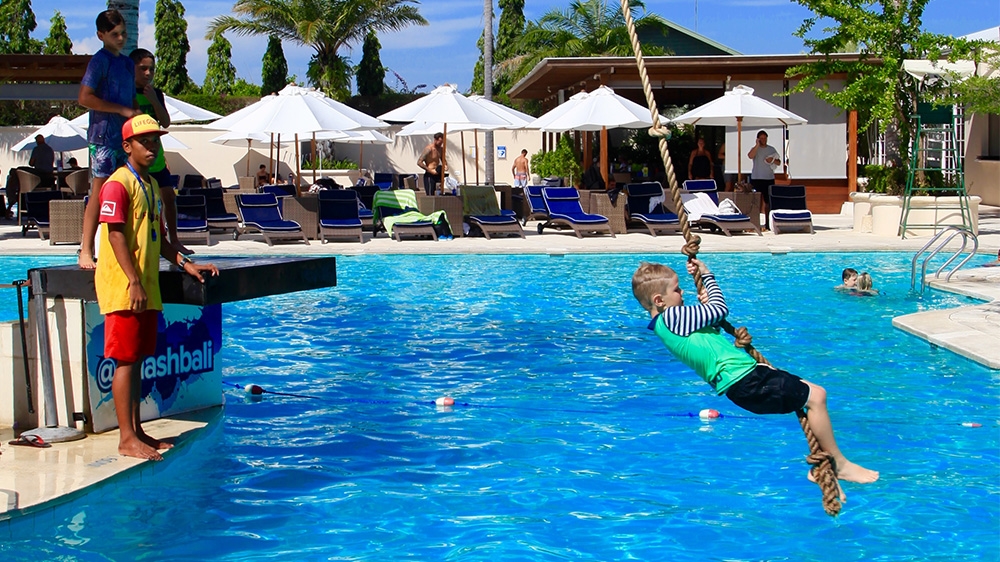Bali: The tropical Indonesian island that is running out of water
Indonesia’s fabled island is running out of water, with monsoon rains delayed and the tourist industry expanding.

Denpasar, Bali – The people of Bali have shared water resources through “subak” – a sophisticated irrigation system that diverts water from channel to rice field and back – since the ninth century. More than just a means to water crops, subak is a manifestation of the Balinese Hindu philosophy of harmony between people, nature and the spiritual realm.
But the diversion of water to urban areas in the densely populated south in recent years and the overuse of groundwater by hotels accommodating the 16 million local and domestic tourists who visited the Indonesian island last year is disrupting the system.
Keep reading
list of 4 itemsPhotos: Heartbreak in Zimbabwe park – Elephants’ desperate hunt for water
Photos: Natural disasters that plagued the world in 2023
‘Everything is dead’: How record drought is wreaking havoc on the Amazon
Coupled with a drought the International Federation of the Red Cross says is affecting 50 million people across Indonesia, including hundreds of thousands in Bali itself, the island is facing a water crisis that is threatening food security, traditional culture and quality of life on the island.
“I believe Bali is in real danger,” said Anton Muhajir, a local journalist who has been covering the water crisis in Bali for a decade.
“Some of my friends have had to move from their ancestral homes in Denpasar because the water in their wells has turned salty. At Jatiluwih, where thousands of tourists go each day to see the most beautiful rice terraces of Bali, farmers are using plastic pipes to pump in water they have to buy in the south because the springs in the mountains are drying up. And now we have drought, not just in Bali but in nearly every province in Indonesia.”

Dewie Anggraini Puteri, fundraising officer for the IDEP Foundation, an Indonesian NGO focused on sustainable development, shares Muhajir’s concerns.
“The subak system is still being used by every village in Bali, but now they’re fighting with people who work in tourism because their water sources are drying out and lots of paddy fields are disappearing as a result,” she said. Sixty-five percent of the island’s water is used for tourism, according to IDEP.
Rivers run dry
In 2017, Stroma Cole, a senior lecturer in tourism geography at the University of the West of England organised a water conference at Bali’s Udayana University.
|
|
The discussions revealed just how serious the situation had become.
Cole had previously authored a scientific paper citing various sources including Indonesia’s own Environmental Protection Agency, that found 260 of Bali’s 400 rivers had run dry, Lake Buyan, the island’s largest water reserve had dropped 3.5 metres and a falling water table was causing saltwater intrusion along Bali’s south coast.
A more recent map shows saltwater is now intruding at many different points all around the island.
“Bali’s freshwater scarcity problem is only expected to get worse unless there is a paradigm shift in the mass tourism model and they embrace quality sustainable tourism,” Cole said. “It’s ludicrous that a tropical island is running short of water.”
Vibeke Lengkong of I’m an Angel, a local charity that provides water aid to villages in drought-stricken parts of Bali, said the authorities had exacerbated the crisis.
“The government has built pipelines to divert water up there from the central lakes, but there’s no water flowing in the pipes because of a lack of funding and corruption that impacts every level of government in Bali,” she said.
“They talk about providing the basic needs of the people, but then they go and sell huge amounts of water to companies like Coca-Cola and Danone-AQUA that have big factories in Bali.”
Lengkong estimates that the average tourist uses between 2,000 and 4,000 litres (528 – 1,057 gallons) of water a day, a figure based on daily water use in luxurious resorts and villas, as well as for swimming pools, gardens and golf courses and building ever more tourist infrastructure.

The demand is depleting the island’s groundwater.
Sayu Komang, a programme coordinator for water projects at IDEP, said new data shows the depletion is much worse than previously imagined.
“We have three major underground water channels in Bali and they are all changing shape and shrinking because hotels are drawing too much water from their wells,” Sayu said. “Our research also shows the quality of the water is really bad, too.”
Rains delayed
IDEP has developed a two-pronged solution for the water crisis: the education of people in both rural and urban areas about water conservation, and the construction of gravity-fed recharge wells that in India have replenished overused water tables within three to five years.
“We’ve built 10 recharge wells in the centre of the island and are planning to build 126 more. The government is also building some in the south,” Sayu said. “But these are only pilot programmes. We need thousands to restore the water table in Bali to a healthy level.”
Set in the shadow of Bali’s revered Mount Agung, Karangasem is the island’s poorest and most undeveloped regency.
This year the El Nino phenomenon has added drought to residents’ woes, creating a longer and hotter dry season.
Now, Indonesia’s Meteorology, Climatology and Geophysics Agency is warning the wet season, which normally begins around now, will probably not start in Karangasem and two other poor regencies in Bali’s north and west until early next year.
Seraya Timor on Bali’s east coast is one of dozens of villages already suffering.
Stencilled by stone terraces built to grow corn, the hills here are so dusty and dry it feels more like a desert island than a tropical one. But it is not water for agriculture that is the residents’ most immediate problem.
Most do not even have access to enough clean water to drink, bathe and cook.

Wayan, a shopkeeper in Seraya Timur who like many Indonesians goes by only one name, said he only has water for three days a week. On other days, he draws water from a 3,000-litre tank that cost him $200 – one and a half times Bali’s average monthly wage.
“I was born in this village and lived here all my life,” he said. “It’s always been dry. But never like this.”
Higher up in the hills, corn farmer Komang’s taps have been dry for more than a week.
He uses foul green water from a concrete reservoir he dug by hand to grow subsistence crops for his family but says he does not have enough water for cash crops like corn. “The rain always comes in December,” he said, looking over the mustard-coloured hills that run down to the sea. “But that’s only 10 days from now and the air – it’s so dry.”
Some 50 kilometres (31 miles) to the north, Tianyar Timor, a village on the slopes of Mount Agung, is even drier; here there are no taps at all. Farmers must instead rely on a series of 5,000 rainwater catchment tanks installed by I’m An Angel earlier this decade.
Need to discuss tourism
But with not a drop of rain since April, the tanks are bone dry and the only way to refill them is with water trucks provided by the state – on occasion.
“Last month, the government brought four water trucks, but this month there have been none at all,” said Ketut, a cashew farmer in Tianyar Timor.
“I hope it rains soon. Otherwise, I don’t know how we’ll survive.”

The Balinese government might finally be taking the water crisis seriously, said Lilik Sudiajeng, a civil engineering lecturer at Bali State Politeknik.
“This year, the governor tasked the bureaucracy to create a roadmap for sustainable water management in Bali with a greater focus on surface water that will have an indirect positive impact on groundwater,” she said.
“There are two dams under construction in addition to the three already we already have and they have built four deep 32-metre (105 feet) recharge wells, as well as 40 shallow ones.”
But Cole says things will not improve until the government takes stock of the elephant in the room – tourism.
“One can say the drought in the north, east and west has nothing to do with tourism because there’s very little tourism there and it’s always been chronically dry,” she said.
“But water from the lakes can be equitably distributed across the island, or it can be massively overused for tourism, as is happening now. They’re damming rivers to divert water to the south whereas they could be directing it up north.
“The villages up there aren’t dry because of drought. They’re dry because of politics, because of choices that are being made.”
With reporting by Lala Samsura